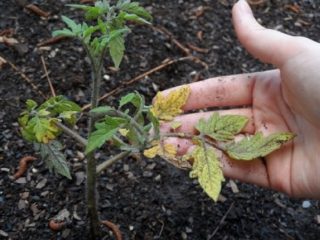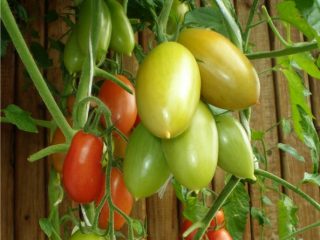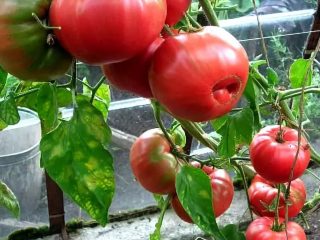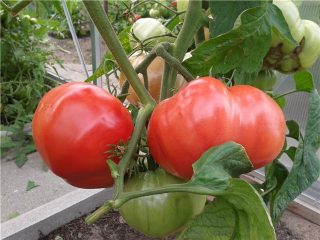Content
Tomato Chernomor is a Russian variety of sweetish tomatoes with a dark purple hue. The crop is characterized by good resistance to adverse weather conditions and produces a stable yield of 8-12 kg per square meter. Recommended for cultivation in the Black Earth Region; most often the bushes are planted in greenhouses. It is in such conditions that maximum performance can be achieved.
History of origin
Tomato Chernomor (Solanum lycopersicum L. var. lycopersicum) was bred by breeders Kondratyeva I.Yu. and Kandova E.E. The originator is the Federal Scientific Center for Vegetable Growing (Moscow region). The application for admission was submitted in 2004, 3 years later (2007) the variety was included in the register of breeding achievements of Russia.
Approved for cultivation in the regions of the middle zone and the Black Earth region - Moscow region, Voronezh Kursk, Tambov, Belgorod, Lipetsk regions and others.
Description of the tomato variety Chernomor
Chernomor is a tomato variety.This is not a hybrid, so seeds collected independently from the fruits can be used for growing next season. The bush is semi-determinate, grows to a height of 130-150 cm. The leaves are dark green, of typical size. Inflorescences of a simple type. The peduncle has an articulation.
Tomatoes of the Chernomor variety are flat in shape, have slight ribbing, and the peel is dense. The fruits are resistant to cracking, medium and large, weight reaches 150-180, maximum 300 g. The taste is good, a pleasant sweetness is noticeable. The pulp is juicy, contains 4-6 nests with seeds. The unripe fruit is green in color and has a dark spot near the stalk. As it ripens, it acquires a dark purple color, which is where the name comes from.
Characteristics of the Chernomor tomato
The Chernomor variety has good resistance to short-term temperature drops. The plant forms ovaries even in unfavorable weather. Therefore, the crop can be grown both in a greenhouse or greenhouse, and in open ground. Ripening time is from 115 to 120 days (the variety is mid-season).
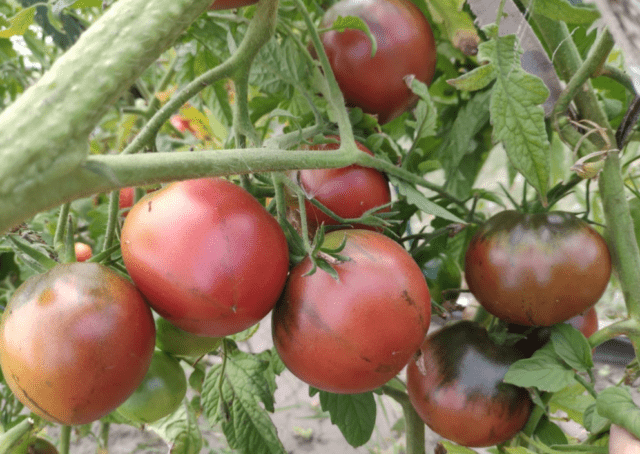
8-10 fruits are formed on each brush
Tomato yield Chernomor
The yield of tomatoes of the Chernomor variety is 2-3 kg per plant, which corresponds to 8-12 kg per 1 m2, for industrial cultivation - from 180 to 500 c/ha. This figure is slightly higher than the Nepryadva and Dar Zavolzhye standards (within 150-495 c/ha). The marketable fruit yield is 73%. Chernomor tomatoes can be grown both for personal consumption and for sale or processing.
Resistance to diseases and pests
The variety is moderately resistant to diseases and pests, and may suffer from late blight. Therefore, when growing, you need to follow the watering norm, do preventive treatments and often ventilate the greenhouse or greenhouse.
Methods of use
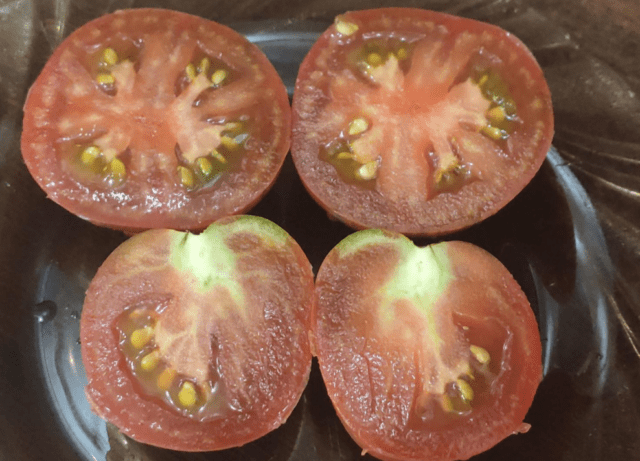
Chernomor tomatoes are especially good fresh
They can be used to prepare salads, cold appetizers, soups and main dishes. The fruits are used to make ketchup. Vegetables are suitable for pickling and pickling. Large fruits will not fit in jars - they can be used for vegetable caviar.
Advantages and disadvantages of the Chernomor tomato
The Chernomor tomato is valued for its good taste and interesting appearance. Despite the fact that the culture is demanding to care for, many summer residents fell in love with the variety and grow it in greenhouses every year. The bushes give a stable harvest. For example, even from 5 m² of plantings you can harvest 50 kg of tasty fruits.

Tomatoes have a pleasant sweetish taste
Pros:
- high productivity;
- large fruits that are not prone to crushing;
- resistance to adverse weather conditions;
- universal purpose;
- transportability.
Minuses:
- instability to late blight;
- requires a garter to the support, pinning;
- Not all regions allow cultivation in open ground.
Recommendations for cultivation
The Chernomor tomato variety is cultivated using the traditional seedling method. Since in the middle zone and the Black Earth Region the seedlings are transferred to open ground in the middle or at the end of May, the sowing of seeds is planned for the second ten days of March. The soil can be purchased at the store or made independently from turf soil, humus, black peat and sand (2:1:1:1). The mixture must be disinfected by pouring a weak solution of potassium permanganate. Instead, the soil can be kept in the freezer for several days or in the oven for 20 minutes at a temperature of 130-150 degrees.
Sowing is done in common boxes, cassettes or containers.Chernomor tomato seeds are pre-soaked in a solution of a growth stimulant (Heteroauxin, Zircon, Epin) and planted to a depth of 1-1.5 cm with an interval of 5 cm. Moistened, covered with a film with holes and placed in a warm place (temperature not less than 23 degrees). After the emergence of shoots, the film is removed, and after the formation of 2-3 leaves, they are planted in cups or peat pots.
Seedlings are transplanted into open ground at the age of 60 days. Planting pattern – 60*40 cm (4 bushes per 1 m2), the depth of the holes is 10 cm. The soil is prepared in advance - dug up and fertilized. Further care for Chernomor variety tomatoes includes the following actions:
- Watering regularly, 2-3 times a week. The water is pre-settled indoors or under the sun.
- Fertilizing with complex fertilizer every two weeks (up to five times per season in total).
- Loosening, especially after heavy watering and rain.
- Periodic weeding.
- Mulching with sawdust, grass clippings, straw.
- Garter to the support and stepsoning. It is better to remove stepsons with garden shears; their blades are pre-treated in a solution of potassium permanganate or other antiseptic. The procedure is carried out once every 10 days.
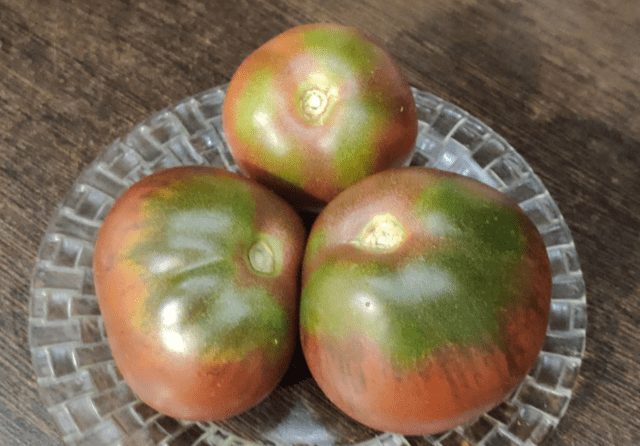
Regular watering and fertilizing ensure high yields of Chernomor tomatoes
Pest and disease control
The Chernomor tomato may suffer from late blight, and in case of excessive watering, from rot. To prevent fungal infections, a few days after transplanting the seedlings, the bushes must be treated with a solution of any fungicide:
- Bordeaux mixture;
- "Fitosporin";
- "Tattu";
- "Maksim";
- "Fundazol".
Tomatoes of the Chernomor variety can also be damaged by insects.Harm to the crop is caused by cutworms, spider mites, aphids, mole crickets and others. To combat them, folk remedies are used: infusion of wood ash, garlic cloves, mustard powder, onion peel, tobacco dust.
In extreme cases, it is permissible to treat with insecticides, for example, Medvetox, Confidor, Decis, Karate and others.
It is better to do the treatment in the evening; for this, choose a dry and windless day (when grown in open ground).
Conclusion
The Chernomor tomato is one of the few purple varieties that can be cultivated in the climatic conditions of the middle zone. The tomatoes turn out juicy, with a pleasant taste and aroma. Medium-sized fruits can be used for preservation, and large ones can be eaten fresh. When growing, special attention is paid to watering, fertilizing, and ventilating the greenhouse.
Reviews from gardeners about the Chernomor tomato

